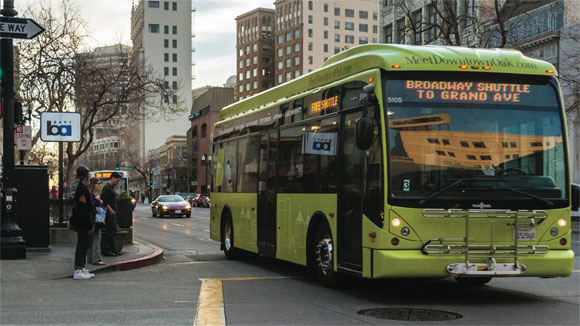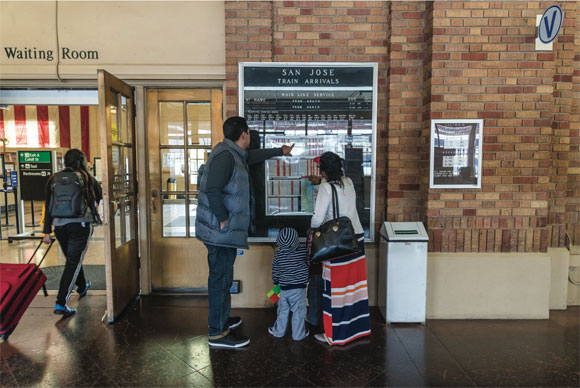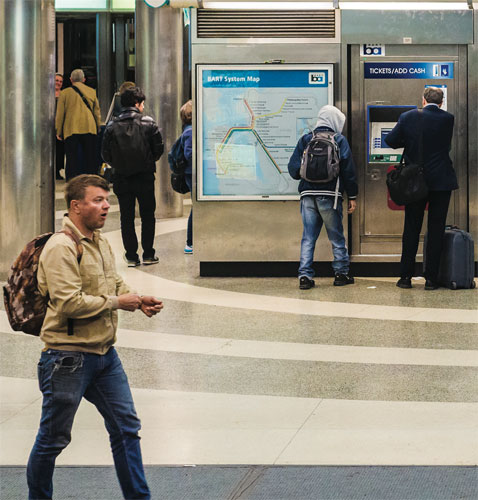Overcoming the Barriers to a Seamless Bay Area Transit Experience
4:04 PM PDT on May 21, 2015

Ratna Amin is SPUR’s Transportation Policy Director. This piece originally appeared in SPUR's The Urbanist.
The Bay Area’s prosperity is threatened by fragmentation in the public transit system: Riders and decision-makers contend with more than two dozen transit operators. Inconsistent transit experiences and disjointed planning and investment make our transit system less efficient, less usable, and less likely to help us meet our goals for a thriving and sustainable region.
The Bay Area economy and labor market is increasingly regional: 29 percent of Bay Area commuters cross a county boundary to get to work each day. These long commutes, many of which traverse the bay, put incredible stress on constrained transportation corridors. Two-thirds of Bay Area commuters drive to work alone, creating significant congestion on the region’s freeways and bridges. Dramatic growth in employer-run shuttles over the last few years demonstrates the demand for alternatives, both to car travel and to regional transit such as BART and Caltrain, which are running short on room for passengers. As people move further out to find affordable places to live, the expectation is that regional travel will grow.
For these reasons and others, such as managing sprawl and reducing greenhouse gas emissions, the Bay Area invests heavily in transit. It is spending $21 billion over the next 25 years to build public transit infrastructure and $159 billion to operate and maintain the transit system. Despite similar expenditures in the past, overall transit ridership has not been growing in the Bay Area. Most trips within the Bay Area are still made by car, with transit accounting for only 3 percent of all trips. Part of the reason it’s hard to increase transit ridership here may be due to how fragmented our system is compared to others.
Many could benefit from more integrated transit
We have the opportunity to increase the market share for transit in places where there is significant demand for regional travel. Half as many people travel from central Alameda County to San Francisco as travel from the Peninsula/Silicon Valley/San Jose to San Francisco, for example. However, 44 percent of the Alameda County trips use public transit while just 17 percent of the Silicon Valley trips use public transit.
For the large segments of our population who can’t afford to own cars or are unable to drive, access to integrated transit means access to the same opportunities that those with cars have; better transit would help these members of the community meet their social needs and enjoy all that the region has to offer.

Fragmented transit is also exacerbating many of our housing challenges, and integrating it could be part of the solution. Areas like the Peninsula and inner East Bay are already oriented around major transit lines, and yet much of the growing transit infrastructure there remains uncrowded. A more seamless, more usable regional transit network could open up infill development opportunities across the region -- without adding more traffic.
SPUR’s research shows that there are many beneficiaries of integrated public transit, including:
- Customers, who experience increased ease of travel as well as greater transit availability and reliability.
- Businesses and institutions, which are able to attract workers from across the region to job sites and meet their sustainability goals.
- Cities, who are trying to grow around transit stations and encourage mode shift away from the car.
- Transit operators, who can better manage demand, respond to contingencies and manage system expansion costs. They can potentially reduce operating costs through coordinating resources, sharing expenses and collaborating for greater buying power. Transit agencies may have greater access to funding and greater public support.
- Taxpayers, who receive greater social or environmental benefits from the resources they put into the transit system.
Having many operators does not have to result in a fragmented system
The institutional setup of Bay Area public transit is arguably the most complex in the United States. Riders navigate more than two dozen unique public transit "brands," including Muni, BART, AC Transit, the Santa Clara Valley Transportation Authority (VTA), Caltrain, and many other bus, rail and ferry operators. Each transit agency operates and plans its system independently and has different funding sources.
In most major metropolitan regions, there is one dominant transit operator, such as MTA in New York City or RTD in Denver. But the largest Bay Area transit operator -- the San Francisco Municipal Transportation Agency (SFMTA) -- carries only 45 percent of the region’s trips. In the Bay Area, using more than one of the region’s transit operators for a single trip is often a necessity, but that doesn’t mean it’s easy. Riders face barriers on trips run by multiple operators, including unfamiliar maps and timetables, multiple fares, schedules that are not coordinated for transfers and long walks between transit connections. Riders also don’t know how to take advantage of all the transit that operates in their city.

A system with multiple operators does not have to result in a fragmented transportation experience. Roads operated by different entities connect seamlessly for drivers, for example. A driver does not need to understand who operates each road and pay each time he or she crosses into a new jurisdiction.
Similarly, multi-operator airline trips can be made with one ticket. There are regions in the world where many different transit operators combine their efforts to look and operate more like a single, unified network -- without actually merging into one operator. Greater London has integrated dozens of transit operators so well that the underlying complexity is completely hidden from the rider.
Better transit integration would not only improve customer experience, it could address other major transit challenges. While some transit lines in the Bay Area have capacity crunches during peak hours (such as Caltrain, BART’s trains across the bay, and many Muni routes), a significant amount of transit capacity goes unused, with buses or rail cars running empty. Local transit systems are costing more while producing less in the way of ridership. That’s untenable. Highly successful regional services like BART and Caltrain are nearing a breaking point because we have not invested sufficiently in their upkeep. This is due in part to a lack of coordination in the region’s problem solving and in its transit investments.
The region needs renewed focus on seamless transit
The idea of integrating Bay Area transit and creating a seamless user experience is not new, but current events make the need for action more pressing.
First, the region has several new multi-billion-dollar transit projects underway, and each could be more successful if it were well-integrated for riders. These include VTA’s BART Silicon Valley Extension to San Jose/Santa Clara, Caltrain’s Downtown Extension in San Francisco, and SFMTA’s Central Subway. Lower-cost projects where integration also matters include bus rapid transit projects by SFMTA, VTA, and AC Transit; the Sonoma-Marin Area Rail Transit (SMART); and Altamont Commuter Express and Capital Corridor intra-regional services in the East Bay.
Not only do these transit projects compete with one another for funding and ridership, but some are being planned in a way that leaves gaps in the network. SMART stops short of the Larkspur Ferry Terminal; the Milpitas BART station is a half-mile away from the closest VTA light rail station; and the Muni T-Third line stops just short of the Bayshore Caltrain station. As a region, we need to make better connections to improve the transit network as a whole and make the most of these investments.
The state’s big transportation initiatives also require integration to succeed: The majority of California’s cap-and-trade program funding is directed to transit or transit-oriented development, and eligibility for new funding may depend on achieving a higher level of coordination. The state is also investing heavily in high-speed rail, which would connect with multiple systems in the Bay Area.
Second, we need to scale existing efforts -- and accomplish more integration sooner. Clipper 2.0, the process now underway to develop the next generation of the Clipper fare payment system, should include transit passes that work across the region. Ensuring better connections at new transit hubs around the region should also be a priority (and it’s a bigger problem than any one agency or advocacy group has been able to address). There is a regional Hub Signage Program, which installs signs to help people navigate the region’s big transit hubs, and it is a significant step toward a more seamless system. But the Bay Area also needs a universal regional transit map that integrates multiple operators.
Third, fragmentation in urban transportation is growing rapidly. New mass transit operators include private employer shuttles, privately run transit vans such as Bridj, Leap, and Chariot, publicly accessible private shuttles like UC Berkeley’s campus circulators and Emeryville’s Emery Go-Round, and city-funded transit like the B Shuttle in Oakland. Public and private personal transportation solutions like Bay Area Bike Share and ride-hailing and ride-sharing services such as Uber, Sidecar, and Lyft are also on the rise. Many of these services are attracting the same market that public transit would, and in many cases they can serve passengers better or for less money. To be part of an integrated system, public transit offerings will need to become more convenient and easier to navigate and understand.
Finally, our region’s growth plans rely on a cohesive regional transit network. Plan Bay Area, the regional transportation and land use plan first adopted in 2013, worked with local jurisdictions to identify locations for growth around transit. The plan focused 66 percent of jobs and 80 percent of housing in Priority Development Areas -- places that have public transit and capacity for growth. To actually achieve these goals, it is necessary to have an integrated transit system that reliably serves this new growth. We could expect more local acceptance of transit projects and growth around stations when they imply access to an integrated regional network.
Key findings on transit integration
SPUR interviewed more than 100 stakeholders and experts in order to understand transit fragmentation problems and solutions. We reviewed case studies both local and global, and looked at academic research on transit integration to understand what aspects of transit fragmentation affect transit’s success.
The key findings of SPUR’s research are:
- Regional and state leaders have sought to integrate Bay Area transit for decades, with mixed success. In the mid-1990s, for example, the state authorized the Metropolitan Transportation Commission (MTC) to address transit coordination. Regional Measure 2 in 2004 provided more funding and authority for coordination. The region has implemented the Clipper fare payment technology, 511 traveler information services, and the regional Hub Signage Program. However, these accomplishments have required significant financial and political resources.
- Local operators have to respond to local priorities. Transit operators often have no incentive to integrate with other operators: Integration can cost time and money, it can take away control over revenue, and it may yield little recognition for the effort. More resources and goodwill are needed to further regional integration efforts.
- SPUR found some apathy among stakeholders about facilitating multi-operator trips. State and federal transit funding programs have not emphasized integration.
- City governments in the Bay Area have had little involvement in promoting transit integration, despite the potential benefits to residents, workers, and neighborhoods.
There is agreement that we need better governance structures to support integration, but there is little agreement on what those structures should be. Governance solutions could include a few operators working as peers, a city or mayor providing leadership, or MTC having a stronger role.
- Consolidating operators could be a governance solution that reduces the need for coordination. However, mergers are difficult to accomplish and the anticipated benefits may not necessarily be realized.
- Effective integration efforts such as fare passes or shared services have taken place at the sub-regional level between two or three operators. But these are difficult to scale up to cover the whole region. Many other integration opportunities are not being pursued due to lack of capacity or a constituency to advocate for them.
- Where transit integration has worked, both in the Bay Area and elsewhere, its success has depended on three factors: a focus on customer experience, the development of trust between agencies, and incremental, bottom-up collaboration. It has also required agencies to articulate goals and track progress toward those goals. Traditional cost-benefit analysis has not spurred integration. Rather, it has taken leadership and vision.
- Data plays a large role in integrating transit, both in providing information to riders and in furthering the business of improving transit. Private-sector solutions like Google’s Transit Trip Planner are now overcoming longstanding information challenges. Making more data about our transit systems available would further improve third party offerings and transit operators’ decision-making.
Should there be mergers?
Mergers, or consolidation, of transit agencies has been a popular recommendation for solving these problems caused by transit fragmentation in the Bay Area. SPUR’s research suggests that maps, fares, schedules and long-range planning would be more cohesive with fewer agencies. However, consolidated agencies are not essential to a better transit experience nor can consolidation be easily facilitated or forced. More importantly, incremental coordination and cooperation between agencies is an effective first step towards full integration. For these reasons, SPUR’s recommendations focus on coordination and cooperation as a first step in the direction of greater integration, rather than relying on the hope of agency mergers.
SPUR’s vision for integrating Bay Area transit
SPUR has identified the barriers to effective coordination and determined the strategies and actions necessary to get from where we are today to a future in which the region’s many transit options function like one system. We have identified five strategies for integrating transit.
Strategy 1: Help travelers understand the value of the region’s transit system and how to use it.
Strategy 2: Standardize fares and develop passes that encourage use of the region’s entire transit system.
Strategy 3: Develop transit hubs that make transferring easy.
Strategy 4: Use an integrated approach to transit network design.
Strategy 5: Use institutional practices to promote integration.
In order to prioritize efforts regarding transit integration, we should ask three questions:
- Will it improve the experience for a lot of customers?
- Does it increase transit’s market share away from private autos?
- Will it help make better places and cities?
If we continue with business as usual, each transit operator will plan and run services separately, with loose coordination from MTC. Each agency will persist in its attempts to solve rush hour crowding independent of other agencies or with only basic coordination across organizational lines. Incremental improvements to 511 and the Clipper card will continue, but each agency will still have different fare policies and traveler information. Each agency will set schedules in a way that meets its own mandates for efficiency, and coordinating connections with other agencies will remain difficult. The region cannot afford to stay on this uncoordinated path.
Without better integration, we will pay for transit that goes underused, and communities won’t have confidence in putting new growth near transit. We think this future is unacceptable for the Bay Area. Tackling inefficiencies and poor customer service are relatively doable, affordable fixes geared at simply making it easier for people to use the public transit we already have.
Currently, regions like ours make commuters learn a dozen different fare structures. People with long commutes -- many of them low-income, many who have to use multiple systems every day -- are financially penalized. Individual agencies are not incentivized to help passengers navigate a trip beyond the end of their line.
SPUR believes that if we can make all of this easier, we can improve the experience of regular transit commuters and quite possibly increase the likelihood that new commuters will join them.
Stay in touch
Sign up for our free newsletter
More from Streetsblog San Francisco
Weekend Roundup: Bancroft Lane Gets Concrete, Party in Downtown S.F.
...and the Bay Bridge to get its lights back
Richmond-San Rafael Bridge Bike Lane Will Need Support
There's no evidence the bike lane contributes to congestion on the bridge
Update on Oakland DOT’s Lakeshore Protected Bike Lane Project
Public seems fairly positive and accepting towards the coming project. Let's hope it stays that way




